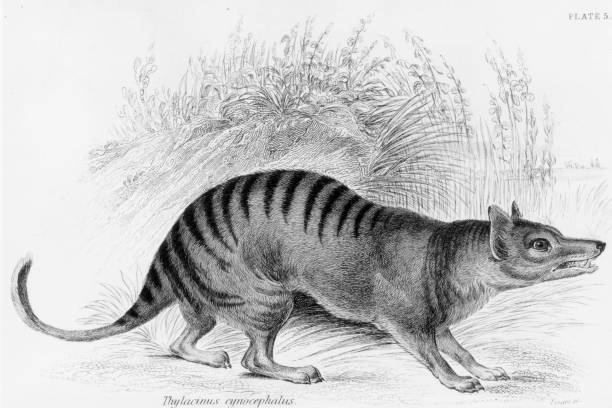The Tasmanian tiger, officially known as the thylacine, had vanished from the face of the Earth nearly a century ago. However, recent scientific breakthroughs have sparked hope of resurrecting this enigmatic creature. Ribonucleic acid (RNA), a genetic material present in all living cells, has played a pivotal role in this endeavor due to its structural similarities to DNA.
Reviving the Thylacine: A Scientific Odyssey
In a pioneering effort, scientists are striving to harness the power of genetics, ancient DNA retrieval, and artificial reproduction to bring the Tasmanian tiger back to life. This ambitious mission achieved a significant milestone when researchers successfully extracted RNA from a remarkably preserved Tasmanian tiger specimen. This particular specimen had been safeguarded since 1891 at a museum in Sweden.
Leading this groundbreaking initiative is Andrew Pask, a professor at the University of Melbourne and the head of its Thylacine Integrated Genetic Restoration Research Lab. While emphasizing the importance of biodiversity conservation, Pask stated, “Our primary focus should always be safeguarding our biodiversity against further extinctions. Unfortunately, we continue to witness a worrying trend of species loss.” He believes that the technology at their disposal offers a glimmer of hope to correct past mistakes, particularly in cases where crucial species have been lost.

A Collaborative Vision for Species Revival
This ambitious endeavor is the result of a collaboration between Andrew Pask’s team and Colossal Biosciences, a Texas-based company founded by tech entrepreneur Ben Lamm and Harvard Medical School geneticist George Church. Both visionaries have dedicated nearly $15 million to a parallel project aimed at resurrecting the woolly mammoth, albeit in a modified form.
A Glimpse into Thylacine History
The Tasmanian tiger, approximately the size of a coyote, once thrived on the Australian mainland but disappeared from there about 2,000 years ago. It continued to exist solely on the Australian island of Tasmania. As the sole marsupial apex predator of modern times, the thylacine played a crucial ecological role. Paradoxically, this also made it a target for human persecution.
European settlers in Australia during the 1800s erroneously blamed the shy and semi-nocturnal Tasmanian tigers for livestock losses. Regrettably, there was no substantive scientific evidence to support these claims. The last thylacine held in captivity, named Benjamin, met a tragic end due to exposure in 1936 at the Beaumaris Zoo in Hobart, Tasmania. This heartbreaking loss occurred shortly after thylacines were granted protected status, underscoring the urgency of species conservation.
A Unique Resemblance and an Ambitious Quest
The Tasmanian tiger, distinguished by its tiger-like stripes, bore a remarkable resemblance to a wolf. The arrival of humans in Australia around 50,000 years ago marked a turning point that led to the significant decline of this distinctive marsupial species.
While the path to potentially resurrecting the Tasmanian tiger is fraught with scientific challenges and ethical considerations, it symbolizes humanity’s commitment to rectifying past ecological imbalances and restoring the richness of our planet’s biodiversity.
Read More
Transform Your Home into a Smart Haven
John D. “Danny” Olivas: A Remarkable Journey from El Paso to Space
A Guide to Pre-Ordering Apple Products in the United States
Google’s Threat Analysis Group: North Korean State Hackers Target Security Researchers
Synthetic Human Embryos: A Revolution in Scientific Understanding
Unveiling the Rarity and Beauty of Pink Diamonds: The Lulo Rose Phenomenon
Personalized 4D Printed Implants Redefining Breast Cancer Treatment
Decoding the Enigma of Earth’s Oxygen Surge: Unveiling Volcanic Sulfur Dioxide’s Role
GOOGLE DEEPMIND: Google’s Stealthy AI Weapon to Spot Deep fake Images!
Pakistani Doctor Sentenced to 18 Years in the US for Assisting ISIS
Exploring the Marvels of Coral Reefs: Unraveling the Darwin Paradox
Historic Milestone Achieved: Chandrayaan-3 Successfully Lands on Lunar Surface
Unbelievable! ISRO’s Chandrayaan-3 Mission Set to Blow Your Mind – New Discoveries Await!
FAQs (Frequently Asked Questions)
What groundbreaking scientific effort has given rise to the possibility of resurrecting the Tasmanian tiger?
Recent scientific advances, including the recovery of RNA samples from a preserved Tasmanian tiger specimen, have opened the door to potentially resurrecting this extinct species.
What is the role of RNA in this endeavor, and why is it significant?
RNA, a genetic material found in all living cells, is structurally similar to DNA and holds the key to the revival of the Tasmanian tiger. Scientists have successfully extracted RNA from a specimen preserved since 1891, making it a vital component of the resurrection process.
Who is leading the initiative to bring back the Tasmanian tiger, and what is their perspective on biodiversity conservation?
Andrew Pask, a professor at the University of Melbourne and head of its Thylacine Integrated Genetic Restoration Research Lab, is at the forefront of this initiative. He emphasizes the need to prioritize biodiversity conservation, especially in the face of ongoing species loss.
What collaborative effort is driving the resurrection project, and how much commitment has been shown toward a similar project involving the woolly mammoth?
The initiative involves collaboration between Andrew Pask’s team and Colossal Biosciences, backed by tech entrepreneur Ben Lamm and Harvard Medical School geneticist George Church. They have collectively invested nearly $15 million in a parallel project aimed at resurrecting the woolly mammoth.
What led to the extinction of the Tasmanian tiger, and why was it persecuted by humans?
The Tasmanian tiger, resembling a wolf with distinctive tiger-like stripes, faced extinction primarily due to human activities. European settlers in Australia during the 1800s mistakenly blamed the thylacines for livestock losses, resulting in their persecution. Despite being granted protected status, the species could not be saved, and the last known thylacine, Benjamin, died in captivity in 1936.
How does the potential resurrection of the Tasmanian tiger symbolize humanity’s commitment to the environment?
The ambitious quest to potentially resurrect the Tasmanian tiger underscores humanity’s dedication to correcting past ecological imbalances and restoring biodiversity. While the endeavor is challenging and ethically complex, it reflects our desire to right the wrongs of the past and ensure a more diverse and balanced planet.

